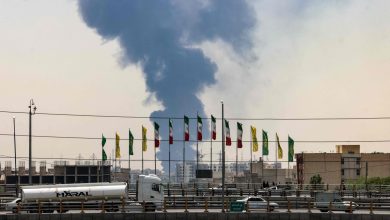Singapore Airlines turbulence incident explained

[ad_1]
The Boeing 777-300ER was diverted to Suvarnabhumi Airport in Bangkok, Thailand, where it made an emergency landing at 3:45pm (08:45 GMT) on Tuesday.
The flight fell into an air pocket while cabin crew were serving breakfast before it encountered turbulence, prompting the pilots to request an emergency landing, Bangkok Suvarnabhumi airport general manager Kittipong Kittikachorn told a news conference.
The airline said 18 people were hospitalised and 12 others were being treated in hospitals. Samitivej Hospital said it was treating 71 passengers, including six who were severely injured.
There were 211 passengers and 18 crew members on board.
A 73-year-old British man died during the incident, likely due to a heart attack, Kittikachorn told a news conference.
Singapore’s Transport Minister Chee Hong Tat said the government would provide assistance to the passengers and their families.
“I am deeply saddened to learn about the incident onboard Singapore Airlines flight SQ321 from London Heathrow to Singapore,” he posted in a statement on Facebook. “My deepest condolences to the family of the deceased.”
After about 11 hours of flying time, the aircraft sharply dropped from an altitude of about 37,000 feet (11,278 metres) to 31,000 feet (9,449 metres) within five minutes as it crossed the Andaman Sea and neared Thailand, according to FlightRadar 24 data.
“Suddenly, the aircraft starts tilting up and there was shaking so I started bracing for what was happening, and very suddenly, there was a very dramatic drop so everyone seated and not wearing seatbelts was launched immediately into the ceiling,” Dzafran Azmir, a 28-year-old student passenger, told the Reuters news agency.
“Some people hit their heads on the baggage cabins overhead and dented it, they hit the places where lights and masks are and broke straight through it,” Azmir said.
Turbulence is incredibly normal and doesn’t pose a risk to the aircraft, but to passengers who are not seated with their seatbelts fastened, and anything else loose in the cabin (such as an open overhead locker with luggage inside, or a crew trolley from the galley).
Because clear air turbulence is almost impossible to forecast (but thankfully quite rare) airlines proactively remind passengers that they should keep their seatbelt fastened at all times, even when the seatbelt sign is switched off.
Of course, there are times when a passenger will need to be without their seatbelt – for a visit to the lavatory, or obtaining something from the overhead locker above, but having a seatbelt gently fastened can protect you from injury should unexpected turbulence occur.
Airline pilots and their respective headquarters plan each flight route carefully depending on weather en route, air traffic, and other parameters with the goal of ensuring a safe, comfortable flight for all those onboard. Air travel remains the safest form of transport.
I fly extensively for work, around twice per week, and globally there are certainly differences in terms of how seriously passengers adhere to the fasten seatbelt sign.
In Europe, adherence is high – and while heavy turbulence is rare across the continent, passengers tend to buckle up and take a switched on fasten seatbelt sign seriously. In Asia, on many Asian carriers, I have noted how a switched on fasten seatbelt sign is not adhered to with as much importance. Passengers still make their way to and from the lavatory as normal, whereas a European carrier crew would likely stop a passenger from doing so, pointing out the illuminated seatbelt sign. Of course, this is a generalisation, but it’s certainly something many of my industry colleagues agree on.
There is no real world data to suggest turbulence is increasing, but there are scientific models that link to a likelihood of an increase in turbulence as a result of more erratic weather patterns due to climate change.
The Bay of Bengal (where this Singapore flight suffered the severe encounter) is known for turbulence due to the geography, pressure and weather formations of the water. But it’s important to note that pilots will always do their best to avoid it, but it is inevitable to happen once in a while – and thankfully it’s rare.
The author is an aviation analyst. Twitter handle: @AlexInAir
[ad_2]
Source link







